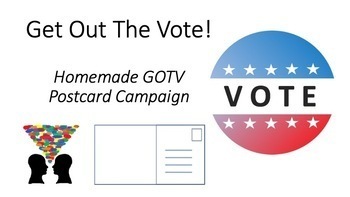GOTV Get Out The Vote Postcard Campaign Project! Full Bundle!
- Zip
Products in this Bundle (5)
Description
Get Out The Vote (GOTV) Project!
In this Postcard Campaign Project, we create GOTV postcards!
We create and splatter alcohol inks to paint 4x6 index cards, learn the legal guidelines for GOTV efforts, discuss the importance of our campaign, and send the cards to actual voters!
The Project is very Flexible and Customizable:
You can trim out any part of the project you wish, or simply offer it as an optional extension project students can do on their own or as an after school club activity!
Through Tangible, Fun, Interesting, Cooperative steps, students will:
* Create Art,
* Reach Voters in personal ways, and
* Influence the Vote!
Applicable lifelong, students will have an easy, low-budget way to make permanent societal change.
It’s easy to get help from friends and family, too, so the fun and engagement with the Vote will spread!
Objectives:
Enhance Understanding of Political, Campaign, and Elections Processes.
Leverage Individual and Organizational power to Influence the Vote.
Collaborate to Communicate the Importance of every person’s Vote.
Appreciate and Do the Work involved in Get Out the Vote Campaigns.
Experience firsthand the ability to Recruit Voters within Legal and Moral Guidelines.
Clarify and Remind Community members of Registration and Election Dates.
Participate with, and Assist, Organizations that Empower and Motivate Voters.
After learning how to create our postcards (the fun splatter paint stuff!), we revisit our big questions. Students are guided through a Forced Turn-and-Talk to answer these Questions:
Q: “Why is it important to Vote?”
Q: “Why is it important that as many people Vote as possible?”
Q: “Why is it important that People from Marginalized Groups get to Vote?”
Q: “Which people are Most likely to Vote? Least likely to Vote?”
You can purchase the whole GOTV Project Bundle to get:
* Full-Project PowerPoint,
* Note-Taking Handout (matches PowerPoint),
* Turn-and-Talk Handout,
* Example photos from my Postcard Paintings, and
* My Personal Voting Story - how I went from apathetic to voting activist!
All you need to source are:
* Guidance for finding Voting Stats
* Materials for Painting (I fully guide you through this in the powerpoint)
* Texts about the History of Voting Rights (optional)
* Current Events / News resources about current efforts to Protect or Limit the right to Vote (optional)
We use my "Forced Turn-and-Talk" format (which I regularly sell in my TPT shop!).
It's fully structured and prepared for you, and included in this product.
This Handout and the greater GOTV Project PowerPoint slides + handout direct students through this exercise. No need to purchase my Forced Turn-and-Talk products unless you wish to implement the exercise for other disciplines or learn how to optimize its structure for English Language Learners.
Students are guided through a Forced Turn-and-Talk to answer these Questions:
Q: “Why is it important to Vote?”
Q: “Why is it important that as many people Vote as possible?”
Q: “Why is it important that People from Marginalized Groups get to Vote?”
Q: “Which people are Most likely to Vote? Least likely to Vote?”
Students turn in their filled-in Handouts - this holds them accountable for full participation. The project is so engaging, however, that they will be eager to investigate these anyway!





